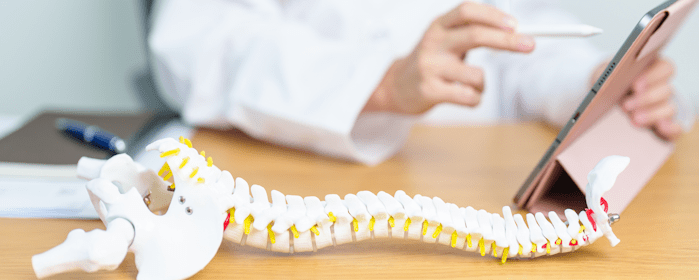Spinal cord injury (SCI) is among the most devastating injuries a person can face, often resulting in partial or complete paralysis and a significant loss of independence. Recovery is usually limited, even with the best available care, leaving millions worldwide with lifelong challenges. Over the past two decades, however, researchers have focused on new ways to encourage healing after SCI. One of the most promising areas involves cell transplantation – particularly the use of stem cells.
In this review, Sugai et. al provides an overview of recent clinical studies and discusses potential advancements anticipated in the future.
Understanding Spinal Cord Injury
SCI occurs when the spinal cord sustains damage, either from trauma like accidents or falls, or from non-traumatic causes such as tumors or degeneration. This damage interrupts communication between the brain and the rest of the body, leading to impairments in movement, sensation, or autonomic functions like breathing and digestion. As the global population ages, SCI cases are increasing due to more frequent minor accidents like falls. Unfortunately, current treatments – such as steroids or neuroprotective drugs – have failed to produce consistent, meaningful recovery for most patients.
The Promise of Stem Cells
Stem cells have the remarkable ability to develop into various cell types and aid tissue repair. In SCI, they offer potential in replacing damaged nerve cells, supporting the injured spinal cord, or creating an environment conducive to healing. Since the early 2000s, clinical trials exploring stem cell therapy for SCI have increased steadily. Multiple stem cell types are under investigation, each presenting unique benefits and challenges for promoting recovery.
Types of Stem Cells in SCI Research
Neural stem/progenitor cells (NS/PCs) can differentiate into several types of nerve cells. These cells may originate from fetal tissue, embryonic stem (ES) cells, or induced pluripotent stem (iPS) cells – adult cells reprogrammed to a stem-like state. NS/PCs are promising because they could directly replace damaged spinal tissue, but they typically require surgical implantation into the spinal cord. iPS-derived NS/PCs, a newer option, may reduce immune rejection risk since they can be patient-specific.
Mesenchymal stem/stromal cells (MSCs), found in bone marrow and other tissues, help heal by secreting factors that reduce inflammation and encourage tissue repair rather than transforming into nerve cells. These cells can be administered intravenously or injected near the spinal cord and are generally low-risk in terms of side effects or tumor formation. Researchers are still working to fully understand how MSCs aid recovery.
Schwann cells and olfactory ensheathing cells (OECs) naturally support nerve growth and regeneration by protecting and guiding new nerve fibers. These cells are relatively safe and usually delivered surgically to the injury site, similar to NS/PCs.
Progress and Milestones
The first human trials using fetal NS/PCs began in 2006, followed by studies with ES-derived NS/PCs in 2009. These early trials established that stem cell transplantation is generally safe but did not result in significant functional improvements. In 2020, Japan launched the first clinical trial using iPS-derived NS/PCs, which remains ongoing. These cells are especially promising due to their versatility and personalized nature.
MSCs-based therapies have also shown encouraging results, particularly in the subacute phase of SCI – the period shortly after injury. A treatment called Stemirac, developed in Japan, has received conditional approval there, marking a significant step forward, although no stem cell therapy has yet been approved by the FDA for SCI in the U.S.
Cell Delivery Methods and Their Impact
The route by which stem cells are delivered to the spinal cord is critical to treatment success. Direct injection into the injury site (intralesional delivery) is the most precise method, allowing the cells to reach the exact area of damage. However, it is also the riskiest and requires highly skilled surgeons to navigate delicate tissue.
Intrathecal injection introduces cells into the spinal fluid, offering a safer, less invasive alternative. While cells can circulate within the central nervous system, not all may reach the injury site, potentially limiting effectiveness.
Intravenous injection is the least invasive, delivering cells through the bloodstream. Although easiest to administer, many cells can be trapped in organs like the lungs before reaching the spinal cord, reducing their therapeutic impact.
Each delivery method involves a trade-off between precision, safety, and ease of use, and ongoing research seeks to determine the best balance.
Challenges in SCI Stem Cell Research
Developing effective stem cell therapies for SCI is extraordinarily complex. One major challenge is the variability of spinal injuries – no two SCIs are exactly the same. Even small differences in injury location cause wide variations in symptoms and recovery potential, complicating treatment design.
Patient factors such as age, overall health, mental resilience, and rehabilitation access further influence outcomes. These variables add complexity to clinical trials, making it difficult to isolate treatment effects.
Measuring improvement is another hurdle. For example, thoracic spinal injuries control fewer muscle groups, so subtle functional gains may go unnoticed. Without clear markers of progress, judging treatment effectiveness remains challenging.
Recruiting patients for trials is also difficult. Many potential participants have complex medical profiles that disqualify them, resulting in small study sizes that limit statistical power.
Despite these obstacles, researchers continue refining methods and adapting trial designs to advance the field.
Emerging Innovations in SCI Treatment
While no stem cell therapy has yet become a standard treatment for SCI, the field is progressing with cautious optimism. Gene editing offers a promising avenue by enabling scientists to modify transplanted cells, reducing immune rejection and adding safety features like “suicide switches” that can eliminate cells if necessary.
Advances in imaging, such as functional MRI, allow researchers to monitor nerve function more precisely, detecting subtle changes and providing better insights into treatment effects.
Artificial intelligence (AI) is also beginning to assist in analyzing complex clinical data, identifying patterns, and guiding research directions, potentially accelerating discovery.
Combining stem cell therapy with intensive rehabilitation shows promise, as physical therapy may amplify the benefits of regenerative treatments and enhance recovery.
Additionally, non-regenerative technologies like brain–spine interfaces are making strides in restoring movement by bypassing damaged nerves. Though beneficial, these devices require ongoing use and do not repair spinal tissue, keeping regenerative therapies a primary focus.
Progress in Stem Cell Therapy for Spinal Cord Injury
As of mid-2024, the FDA has approved 39 cell or gene therapies overall, yet none target neurological conditions like SCI. This underscores the tremendous challenges involved in repairing the brain and spinal cord. The expense, risk, and complexity have caused some pharmaceutical companies to abandon spinal cord research. Nonetheless, scientists continue with ongoing efforts to refine techniques, explore new cell types, and approach patient healing holistically.
The authors conclude that while stem cell therapy for SCI is still experimental, major advances have been made in understanding how stem cells function, the best ways to deliver them, and how to measure outcomes. Although regenerative medicine cannot yet cure SCI, it is steadily advancing toward breakthroughs that could greatly improve quality of life for those affected.
Source: Keiko Sugai, Masaya Nakamura, Hideyuki Okano, Narihito Nagoshi,
Stem cell therapies for spinal cord injury in humans: A review of recent clinical research,
Brain and Spine,Volume 5,2025,104207,ISSN 2772-5294


 St. Petersburg, Florida
St. Petersburg, Florida
